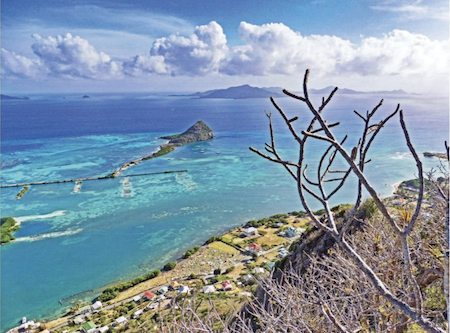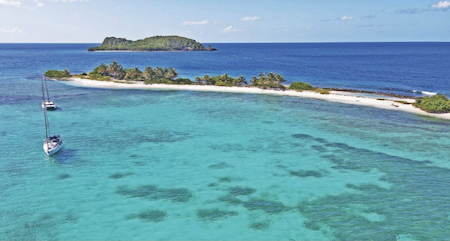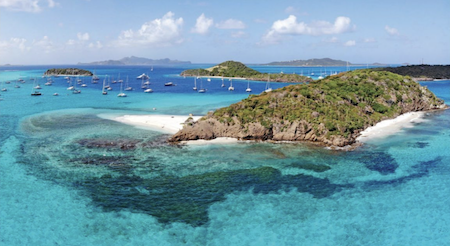Caribbean: An SVG-Grenada Common Sailing Space?
The Caribbean countries of St. Vincent & the Grenadines and Grenada share some of the most superb sailing areas in the world, but sailing between the two can involve hours of form-filling and office visits. In this article for Caribbean Compass magazine, Chris Doyle offers a solution to creating a common sailing space and simplifying the clearing in and out processes between the two countries.
Published 2 years ago
There is no question that shared between the countries of St. Vincent & the Grenadines and Grenada (including Carriacou and Petit Martinique) lies one of the most superb sailing areas in the world.
St. Vincent at the north and Grenada at the south are both mountainous islands with beautiful rainforests and spectacular hiking. Each has an international airport. Between them lie the Grenadines, a string of islands and cays with spectacular white sand beaches, great snorkelling, interesting communities and hikes with wonderful sea views. SVG includes most of the Grenadines, from Bequia to PSV, but Grenada’s small share, with Carriacou and its surrounding isles is also outstanding.
Unfortunately, a line on the map divides the area into two countries. This creates a problem that hinders yacht movement and thus stunts the growth of yachting tourism and the money flowing to both.


- It’s just a short hop between Union Island (foreground) and Carriacou. But at the moment, sailing from one to the other can involve hours of form-filling and office visits.
Sailors, including charter guests wanting to visit the other nation, must first clear out at a port of entry of the country they are in. Then they must go to a port of entry in the other country and even when using the SailClear pre-entry system online, spend more time than they would like waiting in line to clear in before they can go where they want. Then, if they want to return to the first country, they must go to a port of entry (often the same one where they cleared in), go through the outbound clearance routine and then go to a port of entry in the country they started in and do another inbound clearance. Having to consider making four major visits to Customs and Immigration offices which dictates how you spend your time and where you sail in the Grenadines is ridiculous – especially for charterers on a seven-day cruise – and severely limits the movement of yachts altogether.
I would point out here that during the pandemic, Grenada was full of yachts. It is a fabulously popular cruiser hangout and many more of these would have cruised up the Grenadines and spent some money there if it hadn’t been for the country barrier.


- Sometimes reluctance to jump through the clearance hoops means that Sandy Island, Carriacou is the only uninhabited Grenadine islet that Grenada-based charter boats will see.
I have heard that some in St. Vincent have thought that they are in a better position, as they have more Grenadines and therefore anything easing up on restrictions may be bad for them, subjecting them to more competition from Grenada. Such thinking may have had some validity when Grenada had an international airport and St. Vincent did not, but now all the advantages are with SVG. St. Vincent now has an international airport and being only eight miles from the nearest Grenadine, is ideally situated for starting a charter. But St. Vincent’s available space for charter bases is pretty well taken up and there is little room for expansion. Grenada has many more sheltered anchorages and marinas for charter bases, but boaters starting there have a 30 mile slog to windward to reach Carriacou.
It is also true that the fabulous SVG cruising ground has shrunk since I first came here some 50 years ago. While Mustique is still open to visiting yachts, the regulations now involve hefty mooring fees and often prevent visitors from wandering very far ashore. In Canouan, Anse Guyac is now closed as an anchorage, ostensibly due to fisheries concerns, but I am told the owner of the shoreside property does not want to see yachts in “his” bay.


- Whether starting from St. Vincent or Grenada, charter guests want to visit the Tobago Cays.
Yachts are also no longer allowed behind the reef on the windward side of the island, which was one a popular kiteboarding spot. Both the north and south ends of Canouan are gated and while permission can be obtained to enter these areas it is not the comfortable and accessible place it was years ago. As a final blow, the new ownership of Soho House in Charlestown no longer allows yacht tenders to use the dock, thus restricting yachtspeople’s access to the town. PSV now severely limits where those on yachts may walk ashore, though they have by recompense, devoted some space to them and put up a lovely beach bar.
Expanding the cruising area to include Carriacou, Petite Martinique and their associated islands increases its range and diversity and makes it far more interesting for attracting visitors and getting them to return. This has been so obvious to us in the industry that for years, many of us have advocated and pushed for SVG and Grenada to become a single cruising space – to no avail as yet.
Bureaucracy can be a daunting barrier; it feels a bit like bashing one’s head against a brick wall. But to me, the concept of a single space is still a great one and could be achieved with both governments gaining greater revenue while maintaining security.
There are many problems in having a single sailing space. Each country needs to know who exactly is in its waters at any time and the two countries would have to figure out how to divide up the revenue from yacht entry fees.
However, for the first time, I see a solution that only requires minor alterations of the regulations and procedures and keeps all paid fees exactly as they are. This is thanks to the digital age and SailClear.com which, for the first time this year, does both inward and outward clearances and is available in both SVG and Grenada.
The SailClear.com system, by which yacht skippers provide the required information to their next port of entry electronically, is called “pre-clearance” but with some minor tweaking it could become a proper clearance between SVG and Grenada. Four little sessions on a computer are preferable to having to organise one’s whole itinerary around being physically present in certain ports, when certain offices are open.
The way I envisage this working is simple. When a yacht wants to go from one country to the other, they do the clearance – either inward or outward – on SailClear.com. Electronic payment of entry fees (e.g. by credit card) would have to be added to the system. The payment could easily be made via a link to a government site that would, with a simple questionnaire add up the total amount due. The skipper would then pay online and get a digital receipt. (Note that Grenada has been running a very successful online payment system for paying government fees).
Currently there is a hybrid system: part electronic and part paper. When a skipper arrives to clear in, a Customs officer has to view the pre-clearance data online and then print out a few copies and give them to the skipper. The skipper has to pass them on to others, such as Immigration and port officials, who need them. Ideally that would all be done electronically; everyone would be getting all the same information they do now. Currently Immigration and port officers do not have access to the SailClear system. It would be best and simplest if they did. But if Customs would not allow this, then Customs could still print the forms, as it does now and pass them on. The skipper would keep his or her SailClear number and payment receipt as proof of entry. Passports would no longer be stamped by Immigration, as they are not now in many islands and that would be a blessing.
I doubt there are too many realistic security concerns. I wonder, for example how many people sailing between these islands by yacht have, during clearance, ever been apprehended as criminals or not allowed entry.
Electronic clearance would not be adequate for vessels carrying cargo or substantial amounts of high-duty stores. Those entries would have to be done in the regular fashion. But for ordinary pleasure yachts, it would ease the work of Customs and Immigration officers and allow yachting visitors simplified access to both countries.
This simple change would greatly address the existing problem of the country barrier and could add revenue to both island nations.
Published with kind permission from Chris Doyle and Caribbean Compass magazine.
……………………………………………………………………………………………………………………………………….
Related Links:
……………………………………………………………………………………………………………………………………….
The opinions expressed in this article are the author’s own and do not reflect the view of Noonsite.com or World Cruising Club.
Related to following destinations: Bequia, Grenada, Mustique, Petit Martinique, St. Vincent, St. Vincent & the Grenadines, Tyrell Bay & Hillsborough (Carriacou)
Related to the following Cruising Resources: Caribbean Sea, Routing





